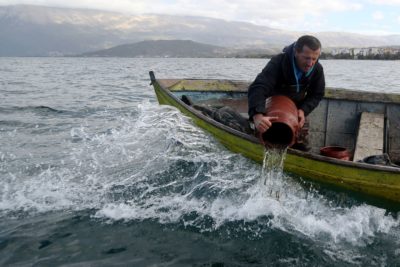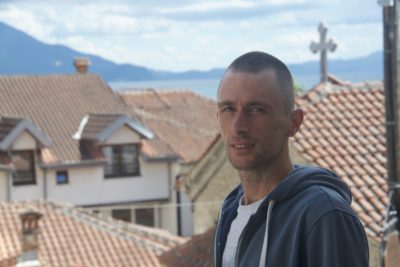On a spring morning, Europe’s oldest freshwater lake is flat and still, its wide surface sparkling. Distant mountains glow mauve and rose, and glass-clear water laps onto a stony shore. Not far away, a town with a history dating back to ancient Greece and Rome stretches along the shore, its whitewashed houses gleaming.
Lake Ohrid was formed almost 2 million years ago. Surrounded by mountains on the border of North Macedonia and Albania, it is one of only 30 ancient lakes in the world. These lakes are dotted with geological curiosities, deep reservoirs of biodiversity and evolutionary centers.
For an ancient lake, Lake Ohrid isn’t particularly large: just 19 miles long, 9 miles wide, and 945 feet deep. But scientists say that per acre, it may be the most diverse lake in the world, rich in fish, snails, leeches, flatworms, phytoplankton and crustaceans. Of the lake’s roughly 1,200 native species, 212 are endemic, found nowhere else.
But Ohrid has its problems too. It faces growing threats from overfishing, nutrient pollution, invasive species, a booming tourism industry, sprawl, government neglect and, perhaps the most unavoidable challenge of all, global warming.
Ancient lakes are home to many species found nowhere else, so once degraded they can never fully recover.
Scientists and local activists are worried. Christian Albrecht, a German ecologist at the University of Geissen who studies the lake, has warned of a “creeping biodiversity crisis.” He and other scientists fear that the problems uncovered in the recent study will become more severe if the lake’s problems continue to be ignored. Report Endemic species will decline or disappear, and Ohrid’s character as a biodiversity treasure trove and evolutionary showcase could be irreparably damaged, according to a report to the Council of Europe by Andrei Sovinci, a protected areas expert at the International Union for Conservation of Nature.
“Of course there is some resilience,” Albrecht says. “Fresh water always comes out of the mountains. The problem is when you have all these different pressures and stressors. At some point, every ecosystem hits a tipping point. We really need to be vigilant.”
Ohrid isn’t alone: Ancient lakes around the world, from Lake Tanganyika in East Africa to Lake Baikal in Siberia to Lake Titicaca in South America, face similar threats to those facing Ohrid. Scientists have already observed declines in endemic species in some places, including diatoms at the bottom of Baikal’s food chain and a species of tiny cichlid fish that dominates Lake Tanganyika and nearby Lake Malawi.
Lake Ohrid.
Robert Atanasovsky/AFP via Getty Images
Most of Earth’s lakes are less than 10,000 years old and formed by glacial activity. In contrast, ancient lakes were formed by mountain shifts, often over millions of years. A few lakes fill craters left by asteroids that struck Earth long ago. A 2018 study listed 29 ancient lakes from around the world, ranging in age from about 130,000 years ago to more than 65 million years ago.
Ancient lakes have long fascinated scientists with their incredible biodiversity and the large number of endemic species that have evolved and survived in these waters throughout history. Early studies focused on cataloging the lakes’ diversity. More recently, scientists have been studying the environmental history of lakes to better understand how evolution has produced so many species. Using a variety of techniques, including DNA analysis and deep coring of sediments, scientists have examined how past changes in climate and regional conditions have influenced the timing and direction of speciation. One thing is clear: ancient lakes have served as cradles for new species and refuges for existing species during times of change.
There’s a lot scientists don’t know about ancient lakes. Because they’re large and deep, they’re relatively resistant to major changes. But they’re also vulnerable to climate change, nutrient pollution, overfishing, and other problems that have built up over the decades, scientists say. And because ancient lakes are home to many species that can’t be found anywhere else, once they’re degraded they can never fully recover.
One study found that visibility at Lake Ohrid fell from a depth of 54 feet in 1920 to just 43 feet in 2005.
“If you lose some of it, you can never get it back,” says Catherine O’Reilly, an ecologist at Illinois State University who studies climate change and its effects on Lake Tanganyika’s fish. In addition to curbing nutrient pollution and reducing overfishing, the scientists suggest greater protection for parts of the lake that are representative of the whole lake or that are the most biodiverse.
North Macedonia is one of the poorest countries in Europe, with high unemployment, low wages and few resources. In recent years, tourism has become one of the few ways to boost the economy, with visitors drawn not only by Ohrid’s beauty but also by its relatively affordable prices.
To accommodate and attract these tourists, new hotels, apartments and restaurants have been built near the lake, and construction continues, despite a ban on new construction within 50 metres of the lake shore. New buildings, new marinas and increased boat traffic are destroying or damaging habitats such as wetlands and reed beds in many areas.
“Failed municipal treatment systems (sometimes with sewage pipes flowing directly into the water) and agricultural pollution in the watershed are also contributing to pollution. Nutrients from these two sources are causing algae to build up on the rocky lake bottom near populated areas, clouding the clear water and degrading shallow habitat for native species. Studies in coastal areas have also documented a shift from diatoms and invertebrates that thrive in nutrient-poor environments to species that thrive in nutrient-rich environments.”

Last November, fishermen released juvenile Ohrid trout into the Albanian side of Lake Ohrid.
Adnan Besi/AFP via Getty Images
Lake Ohrid and other cold-water ancient lakes are oligotrophic, meaning they have few nutrients, making them incredibly clear. Oligotrophic lakes are also rich in oxygen and life all the way to the bottom. But over the decades, Lake Ohrid’s water clarity has declined; one study found that visibility fell from 54 feet deep in 1920 to 43 feet in 2005. Scientists have noticed changes in the species composition of its deepest waters, including an explosion of deep-sea algae and an increase in the number of small fish that feed on the algae. The ranges of some mussels have narrowed, and some snails have become rare.
Ohrid’s most famous fish species is the Ohrid trout. The Ohrid trout is endemic to the lake and has long graced the local dining tables. But overfishing has drastically reduced its numbers, making it illegal to catch it on the Macedonian side. People say poaching is common, though. At the same time, Ohrid trout faces new competition from seven invasive species of fish, including rainbow trout. Other invasive species have also invaded the lake, including two new snail species, but these have not yet displaced the native species. Even more worrying may be the proximity of zebra mussels and quagga mussels, native to the Black Sea, which have caused significant ecological damage in the Great Lakes of North America. They could easily reach Lake Ohrid by clinging to boats, wading in a bucket of water with bait, or by holding on to some kind of gear.
“To me, it’s just a matter of time,” Albrecht said, “and what happens when they encounter native mussels?”
Some people are afraid to criticise the government’s inaction for fear of getting into trouble with local authorities, conservationists say.
Gastropods, a classification that includes snails and slugs, are one of the most diverse groups in the lake. Scientists have found 68 species of snails, three-quarters of which are endemic. But for these tiny organisms, even small changes, like algae colonizing rocks, can have big effects, Albrecht says. “Where there used to be meadows of aquatic plants, all of a sudden you get a forest of algae. These changes are dramatic and will undoubtedly lead to the disappearance or local decline of these animals.”
Climate change poses a bigger challenge. Scientists worry that rising surface temperatures will lead to more stratification and less mixing in the water column. This could strip oxygen from the deep ocean, endangering the many endemic species that live there. Nutrient pollution, particularly phosphorus from sewage, intensifies this effect by further reducing oxygen levels. Researchers estimate that if temperatures rise as predicted by the end of the century, Ohrid’s phosphorus would need to be cut in half to prevent deep-sea creatures from becoming so oxygen-depleted that they cannot survive.
Lake Ohrid is not without its defenders. The local environmental movement is small but passionate, with a small but strong membership but a deep attachment to the lake. One of them is Nicola Pascali. A diver, archaeology enthusiast and environmentalist, he has spent years exploring the lake and, with the support of the United Nations, recently produced a video series for primary school children to draw attention to the lake’s problems.

Conservationist Nicola Pascali.
Richard Martens
But in a poor country like North Macedonia, it’s hard to raise awareness of the lake, he said. “You have to solve the social problems first, and then you can solve the ecological problems of the lake.”
Among the most enthusiastic activists are members of Ohrid SOS, a small group that has worked to bring the lake’s problems, including illegal construction and the degradation of the lake’s last remaining wetlands, to wider public attention. But political activism is dangerous, says Katerina Vasileska, a local tour guide and SOS member. She says more and more people are becoming interested in the environment and her group’s work, but are afraid to speak out or criticize the government’s inaction for fear of getting into trouble with local authorities or losing their jobs. (The city of Ohrid declined to comment.)
“People are much more aware,” Vasileska said, “but they don’t have the will to fight. They’re passive.”
Dušica Irek Boeva, a biologist at the PSI Ohrid Institute of Hydrobiology, a research center founded on the lake’s shore in 1935, is more hopeful. She’s also a teacher, and on a recent spring day, she introduced Lake Ohrid’s ecosystem to a group of ninth-graders from the capital, Skopje, three hours away. While she used computer diagrams to explain the food chain, the students poked around in sediment samples from nearby springs and other sites connected to the lake, plucking with tweezers the tiny, wriggling creatures that contribute to Ohrid’s vast biodiversity.
Irek Boyeva was pleased. She thinks the next generation will do better. “If this lake has been here for 2 million years, hopefully it will outlive us,” she told her students.







